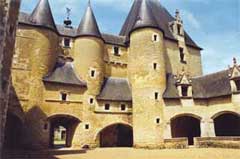Chivalry
Chivalry, described by Chrétien de Troyes, and adopted by women like Eleanor of Aquitaine, known as the Crusader Queen, arose from a German custom which later was idealized by the Church. It is less an institution than an ideal.

Chivalry - A term deriving from the description of military duty on horseback
In his Germania, Tacitus, the historian of the Roman Empire, refers to a German rite in which all the military elements of the future Medieval Chivalry can be found. It is a passage describing a solemn ceremony taking place in front of the general assembly of a Germanic tribe. Into the midst of this assembly advances a very young man, with long fair hair and sea-green eyes.
The chief of the tribe gravely places in the hands of the young man a sword and a buckler. In the absence of a ruler, it would be the father of the youth who undertakes this delivery of weapons. Tacitus said that this was the “first honour of their youth.” Until then, the young man belonged only to his family. Following the rite, he becomes a member of the commonwealth.
From now on, the youngster will never abandon the sword and buckler, as the Germans were always armed, in private as well as in public. And, once the ceremony finished, the tribe will have one more warrior.
The solemn handing of arms to the young German was the first germ of Chivalry which will animate Christianity.
With the fall of the Roman Empire, Germanic people occupied the Northern and Central Europe. Initially, their main military force was the infantry. Gradually, a great change took place, resulting in the cavalry being the strongest arm of military power.
The languages formed on the Latin basis derived their phrases describing the military duty on horseback from the Latin word caballus (horse), resulting, for example, in the French "chevalier." In languages of Germanic origin, the same duty was expressed by words literally signifying service, thus the German knecht, the Saxon cnight, are synonymous to the French chevalier, or the Italian cavaliere. The word rider also designated the same person, preceded by, or standing without, the word knight.
To summarize, the word itself is of Roman origin, but what Chivalry means is German. The adoption of arms in the German fashion remains its true origin.In the kingdoms which appeared from the ruins of the Roman Empire, every king, baron, and military person of estate was a knight. As such, knighthood and the feudalism of Europe coexisted.
In the Merovingian period we find a certain number of small proprietors, called vassi commending themselves to other men more powerful and more rich, who were called seniores. To the senior who made him a present of land the vassus owed assistance and fidelity. As early as the reign of Charlemagne, he followed the senior to war, but it was to the emperor, representing the central power, that he actually rendered military service.
These rules of feudalism have nothing in common with Chivalry. If Chivalry is in fact considered as a privileged body into which men were received based on certain conditions, and with a certain ritual, it is important to observe that every vassal is not necessarily a knight. There were vassals who, in order to avoid the cost of initiation or for other reasons, remained pages all their lives.
On the other hand we see conferred the dignity of Chivalry upon people who had never held fiefs and who owed allegiance to no one, and to whom no one owed any. It was not the knight, it was the vassal who owed military service, “relief and homage” to the lord.
The feudal system soon became hereditary. Chivalry, on the contrary, has never been hereditary, and the special rite has always been necessary to create a knight.
To conclude: The adoption of arms in the German fashion remains the true origin of Chivalry. The rite, which solemnly invested the knight with the sword, the symbol of Chivalry, is completely separated from feudalism, and will decidedly mark the code of manners of people in the Middle Ages.

